What are warts? We will analyze the causes of events, diagnoses and treatment methods in an article by a dermatologist with 37 years of experience.
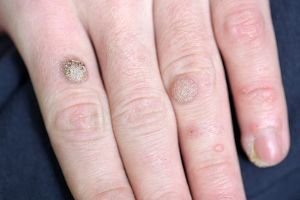
Definition of disease. Causes of the disease
Wartsare irregular, mild benign skin lesions in the form of localized overgrowth in the upper layer of the skin (epidermis) with papules (nodules) or bumps.
The incidence of warts in adults is 7-12%, in school-age children - up to 10-20%.
Warts are very similar to other skin growths. Normally an individual cannot determine the disease on their own and therefore a dermatologist must be consulted to make a diagnosis.
Human papillomavirus is the cause of warts. The type of virus affects the type of warts that can develop. Thus, each type of papillomavirus infects human tissue at its characteristic location.
| HPV type | Preferably location |
types of warts |
|---|---|---|
| 1 | Feet, knees, palms, hands, fingers |
Plants and palm warts, rarely simple warts |
| 2, 4 | Hands, fingers, knees, less often - feet |
Simple warts, sometimes plants, palms and mosaic warts |
| 3, 10 | Skin, hands, face | Flat warts |
| 7 | Hands, fingers | Butcher's Warts |
| 5, 8, 9, 12, 14, 15, 17, 19-24 |
Face, arms, torso in front |
Epidermodysplasia verruciform |
Viral infection usually occurs on contact - with direct contact between infected and healthy skin (for example, when shaking hands) or indirectly (through the handrail, toys, etc. ). Therefore, it is possible to be infected with human papillomavirus, which causes warts, in various places - in public transport, at school, at work, at home, in places with high contact and humid environment (swimming pools, saunas, fitness center). Minor epidermal lesions, through which viruses penetrate, as well as inflammation of the skin, contribute to infection.
Also promotes the appearance of warts:
- immunodeficiency (including HIV infection);
- warm and humid environment;
- need for contact with meat and fish ("slaughter warts").
Some types of human papillomavirus are transmitted from parents.
But bugs and frogs, despite the horror stories we are so often afraid of as children, cannot be transmitted - this is one of the most popular myths about this disease, which has no basis.
Contact your doctor if you experience similar symptoms. Do not use this medicine yourself - it is dangerous for your health!
Warts
Symptoms vary by wart type.
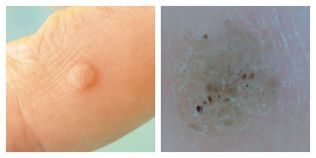
Common warts:
- Round dense papule with normal color, 1-10 mm and larger.
- The surface of the papule is covered with cracks, layers.
- If a papule is on a finger, the print will disappear and be distorted. The same goes for palm drawing.
- Simple warts are either located or in several parts - they usually appear in places with the most injuries (hands, fingers, knees).
- When examined with a skin disease, your doctor may see small brown spots - thrombotic (clogged) capillaries. Patients often refer to these items as "roots". This is the main characteristic of a doctor: it can be used by a dermatologist to diagnose the wart from other similar diseases (for example, molluscum contagiosum and keratoma).
warty (horny):
- The main symptom that usually causes a patient to see a doctor is pain when pressed and walking.
- Such warts are usually located on the feet.
- On contact with a physician, a usually visible keratinized, uneven plaque of normal color, although in the first stage an even, smooth papule is visible. With keratinization, the capillary can only be seen if the keratinized layer of the skin is removed.
- The skin of the ile is distorted.
- Plantar warts are usually solitary, but there are also 2-6 warts;
- These warts are often confused with corn (especially dry) - this is the description of the problem that patients usually come to see.
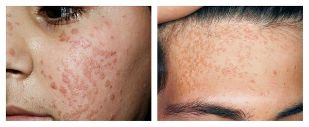
Flat (young) varta:
- It looks like a round, clear, smooth papule with a natural, pink or brownish color, 1-5 mm in size.
- Appears on hands, skin, very often on face.
- There are always some such warts - they are located in groups.
Epidermodysplasia verruciform (senile wart):
- Large, round, numerous combined tumors of normal, pink or brown color.
- Most often appear on the face, arms, front of the abdomen.
- May be confused with corneal tumor, colon and skin cancer.
Metastatic warts
When it enters the body, human papillomavirus can be in a latent state for a long time - you usually do not even know it exists. When factors that are beneficial to the virus appear, it begins to "multiply" in the epithelial tissue leading to tissue exchange.
Unlike other viruses, human papillomavirus does not destroy the cells of the epithelium itself - they die out naturally, naturally, in the process of keratinization and peeling.
Local factors and the state of the immune system affect the spread of infection. For example, people with HIV or kidney transplants are more likely to get warts. In addition, these tumors are often difficult to treat. With normal immunity, the virus does not affect the deep layers of the skin, so many people get warts on their own after a few months.
The main stage in the appearance of warts is the acceleration of the frequency of cell division and growth with the help of the virus. This rapid metabolism leads to thickening of the skin layers. As the tissues grow in a specific, small area, a tuber, called a wart, appears.
Classification and stage of development of the wart
There is no generally accepted classification of warts. However, there are some common variations:
- The prevalence of wartsis the most common type (70% of warts are just them). Such tumors are not found and cause only aesthetic discomfort.
- Plantar warts- appears on the soles of the feet, is painful, needs treatment. Skin injuries due to uncomfortable, tight, torn shoes contribute to the development of such a wart.
- Flat warts- appear more often in young people, adolescents. This is due to unstable hormonal young people who affect the whole body. Flat warts are usually almost invisible.
- Senile warts- typical of the elderly. They often appear on the part of the body that is covered with clothes, but can appear on the face and hands. If there is no discomfort, such warts should not be treated - healing in the elderly can be much slower than in the younger ones, due to slow metabolism.

Other authors report more on these warts:
- Mosaic warts(HPV 2, 4) - tumors of the palms and soles of the feet. They look like the concentration of hyperthyroidism, e. g. e. a. s. thickening of the stratum corneum (usually in the forefoot), covered with deep cracks.
- Bladder warts(HPV 60) are a rare type of foot tumor. It is a soft knot with cracks. Upon opening, a white-yellow discharge appears, similar to cheese.
- Filiform wartsare thin horny growths near the mouth, nose or eyes.
- "Butchers" warts(HPV 7) - appear on the hands and fingers of people who are in constant contact with meat and fish. Presented as an overgrown tumor similar to cauliflower, but of a normal color.
In addition, the types of warts are distinguished by their location.
So, genital warts - tumor-like tumors that appear on the genitals (especially in the areas where the skin changes are mucous membranes) are a common disease. They are usually caused by HPV types 6 and 11.
Complications of the wart
The main reason why patients with warts go to the doctor is an aesthetic defect that can affect the patient's quality of life, his confidence and develop a lot of complexities. Complications can also include cracks on the surface of the wart and addition to infection and in some types of warts, soreness when walking.
Nipples usually do not develop into malignant tumors, they are relatively harmless, but in rare cases such complications can still occur in people with suppressed immune systems.
Other complications occur when trying to remove tumors on your own. In this connection, inflammation and aesthetic defects in the form of scars can occur, as well as further spread of the virus through the skin, because in the morning after one wart has been removed itself, it can wake up with some new ones.
Remember that under the guise of spring you can hide any other disease that can not be determined without the advice of an experienced doctor.
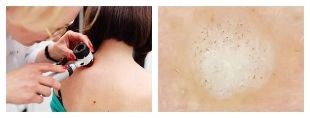
Guard analysis
Examination (clinical picture) and anemia (medical history) are usually sufficient to diagnose.
To confirm the diagnosis, your doctor may perform a histological examination - examination of the cells in the tumor.
It is very important to perform a differential diagnosis - to distinguish warts from other diseases. For example,common wartsmust be diagnosed from the following diseases:
- Molluscum contagiosum- appears more often on the body and genitals, less often on the hands and feet. It is a cerebral hemisphere that affects the surface; when pushed from the sides, a whitish gruel is released.
- Verrucous nevus epidermal- often lonely, one has from birth. It rises above the surface of the skin, often covered with hair.
- Basalioma- a fist-shaped tumor, covered with a crust in the middle. Typical for the elderly.
must be diagnosed from the following diseases:
- Keratoderma- large areas of keratinization and inflammation of the skin. No clotted capillaries.
- Palmar-plantar syfililides- many painless tumors, peeling of the skin along the edges. Syphilis has a positive response
- Grain- usually painless, can only cause pain when pressed vertically.
Your doctor must also distinguish other types of warts from a number of diseases. If other pathologies are suspected, he may prescribe additional tests (for example, detection of antibodies against viruses, CT or MRI).
Warts treatment
Warts are treated for aesthetic purposes and to improve the patient's quality of life. It is only possible to prescribe a doctor after an examination and a precise diagnosis. Independent attempts to get rid of the wart are unacceptable, as a patient without medical training and the necessary equipment is not able to accurately determine the disease and complications after such "treatment" occur much more often than recovery.
There are several ways to treat warts. All of them are performed under the supervision of a doctor and some of them - only in the treatment room of the clinic.
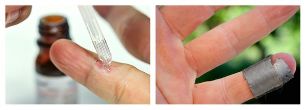
Chemical Healing
Milk-salicylic collodion and salicylic patches are used to get rid of the wart. The proportion of medicines and their method of use (long-term wearing patches, use, etc. ) depends on the prevalence and location of the tumor.
Solutions of zinc and 2-chloropropionic acid can also be used. In this case, the chemical composition is applied to the pre-treated surface, which is left on the wart until the color changes (depending on the type of wart). The procedure is repeated several times after 7, 14 and 21 days. Before each operation, the web is removed mechanically.
Another chemical process is a combination of nitric acid, acetic acid, oxalic acid, lactic acid and copper nitrate trihydrate. In this way, only relatively small tumors are treated - up to 5 mm. The solution is also left to change the color of the wart. After 3-5 days, the patient is followed up, if necessary, he is prescribed another operation in 1-4 weeks.

Cryodestruction
This procedure consists of freezing the wart with liquid nitrogen: the moist tampon is pressed onto the damaged skin (by trapping the tissue around by a few mm) for 1-5 minutes. Some wounds require multiple treatments every four weeks to heal.
The main disadvantages of cryodermination are pain and delayed effects compared to other methods, as only one method is often enough to remove.
Electric coagulation
Under the influence of electric current, the wart is removed in layers. Such an operation is performed with a local anesthetic.
This method is more effective than debridement, but it has significant disadvantages: coagulation often leaves scars at the point where the warts are removed. For those patients who seek to correct cosmetic deficiencies,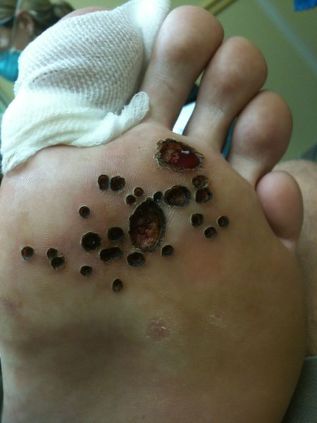 this method will not work best.
this method will not work best.
Destruction of solvent
The laser also removes warts in layers. The fiber-optic cable touches the skin from a few seconds to three minutes, depending on the size. Then the incision is made and the bottom of the wound is treated with solvent again. The patient is then instructed on how to treat the wound. The operation itself is performed under the influence of local anesthesia.
Radiation Surgery
Radiowave surgery is one of the most modern and gentle methods for removing benign tumors, e. g. mt warts.
The method is based on the formation of electromagnetic waves with different frequencies: from 100 kHz to 105 MHz. During the operation, the tissues withstand the lying waves and therefore release molecular energy into the cells that heat the skin. Under the influence of heat, the cells actually evaporate - a neat cut is obtained. At the same time, no mechanical forces are applied to the web in question.
Advantages of this method:
- security;
- rapid wound healing;
- good cosmetic effect - scars and scars are excluded;
- relatively painless - local anesthetic used for minor surgery;
- exclusion of another infection due to automatic disinfection of the electrode when the device is switched on.
The success of this method is recognized worldwide, but it is rather difficult to find a clinic that uses a method of radiosurgery.
Which method to select
All of the above methods have some drawbacks:
- In the first few weeks, the area of operation looks unattractive - crust, dark tissue. This should be taken into account if the warts are on visible body parts (for example on the face).
- Unpleasant odor and pain during surgery.
In addition, each of these methods has contraindications, which you need to find out in consultation with your dermatologist.
But the main drawback isthere is a high probability of relapse, especially if the warts were widespread, extensive. With each of these methods, doctors do not fight for the root of the disease, but for its consequences, since today it is not possible to curehuman papillomavirus.
Therefore, treatment is directed to:
- or eradication of tumors that appear locally when the virus was introduced;
- either to stimulate the immune response against viruses;
- or a combination of these methods.
Most commonly, destructive therapies are used. Their efficiency reaches 50-80%.
Childhood is not usually a contraindication to surgery. Therefore, many of them (including radiotherapy) are also used to treat warts in children. An exception is the chemical removal of warts due to the possibility of side effects on the substance.
What to do after the action
After any of these procedures, be sure to follow your doctor's advice.
After the tumor has been removed by any of the methods presented, your doctor will usually prescribe treatment at the removal site. It is forbidden to remove the "crust" on its own, wet the wound and expose it to direct sunlight.
If a patient is constantly suffering from warts, he should consult an immunologist - he may need chemotherapy, which will increase the immune system for the symptoms of human papillomavirus.
Prediction. Prevention
If the patient does not have an immunodeficiency, the warts can go away on their own, but it will take a long time - from a few months to a few years. So, in 65% of cases, warts recede independently within two years. If the wart is still in place after two years, it is recommended to remove it. It is recommended to remove multiple growths immediately.
With normal immunity and the right method of removal (depending on the size and type of wart) it is possible to remove the pathogenic tissue and achieve a good cosmetic effect. With reduced immunity and other predispositions, human papillomavirus causes remnants in the body.
There is no specific disease prevention. But is infection so inevitable?
You can reduce the risk of a virus by following a few rules:
- Avoid walking barefoot in public places where there is a possibility of skin lesions and viral infections (swimming pools, gyms, gyms).
- Choose quality footwear, change it often. Try to keep your feet dry. Temperature and humidity are excellent breeding grounds for human papillomavirus.
- Go to a certified nail technician to prevent manicures and make sure they use sterile instruments.
To prevent genital warts, according to the WHO (World Health Organization), quadruple human papillomavirus vaccine is also very effective. There are currently no vaccines available to prevent other types of warts.
If you find a single wart, do not try to cauterize, cut or pluck it by yourself - this way you can promote inflammation and further spread of the virus along the skin. After such a "transfer", instead of one wart in the morning, you can wake up with ten.














































































